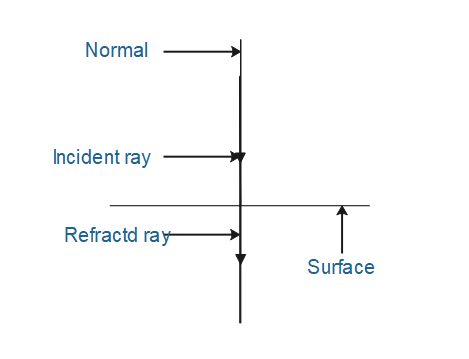
During normal incidence of light:
A. Angle of incidence is ${{90}^{\circ }}$
B. Angle of incidence is ${{0}^{\circ }}$
C. Sum of angle of incidence and angle of reflection is ${{90}^{\circ }}$
D. Angle of incidence is greater than angle of reflection.
Answer
545.4k+ views
Hint: When a ray incident on obstacle or surface or medium, it makes an angle with normal direction of normal ray or normal is always perpendicular to surface i.e. angle is ${{90}^{\circ }}$ and angle of normal with itself is zero. When ray incident along a normal ray it makes ${{90}^{\circ }}$ angle with a surface of ${{0}^{\circ }}$ angle with itself.
Complete step by step answer:

When a ray of light is incident on a surface or any medium from source, it makes some angle with the surface, with normal as well as with refracted ray. Angle between incident ray and normal is known for angle of incidence whereas angle between refracted ray which gets refracted because of surface and normal is known for refracted ray.
Normal is ray when always staying perpendicular to the surface and angle between them is always ${{90}^{\circ }}$ . whereas angle between normal with itself is zero.
Now, if incident ray incidents normally to the surface i.e. along normal ray then it makes zero angle with normal and this is known as normal incidence of light on the point of incident.
If incident ray makes any other angle other than zero degree then angle of incidence is known as oblique angle.
Therefore, option (B) is the correct option.
Additional information:
When a ray of light is incident on the interface of two mediums, part of light is reflected back into the same medium and this phenomenon is known as partial reflection. Whatever be the remaining part, light gets transmitted in the second medium. This is known as refraction of light. These two laws are applicable & obeys at the interface only.
The incident ray and refracted ray are always on the opposite sides of the normal or interface at the point of interface. All three lie in the same plane.
Note: The angle made by incident ray with refracting surface or interface or medium is known as glancing angle as shown in figure. If the angle of incidence is incident along the surface or interface then the angle between incident ray & normal is ${{90}^{\circ }}$ . In this case option (A) will be correct. If angle of incidence and angle of reflection is the same then sum of angle of incidence and angle of reflection is ${{90}^{\circ }}$. When incident ray passes from a rarer medium to a denser medium, it bends towards the normal, in this case angle of incidence is greater than the reflection then option (D) will be the correct option.
Complete step by step answer:

When a ray of light is incident on a surface or any medium from source, it makes some angle with the surface, with normal as well as with refracted ray. Angle between incident ray and normal is known for angle of incidence whereas angle between refracted ray which gets refracted because of surface and normal is known for refracted ray.
Normal is ray when always staying perpendicular to the surface and angle between them is always ${{90}^{\circ }}$ . whereas angle between normal with itself is zero.
Now, if incident ray incidents normally to the surface i.e. along normal ray then it makes zero angle with normal and this is known as normal incidence of light on the point of incident.
If incident ray makes any other angle other than zero degree then angle of incidence is known as oblique angle.
Therefore, option (B) is the correct option.
Additional information:
When a ray of light is incident on the interface of two mediums, part of light is reflected back into the same medium and this phenomenon is known as partial reflection. Whatever be the remaining part, light gets transmitted in the second medium. This is known as refraction of light. These two laws are applicable & obeys at the interface only.
The incident ray and refracted ray are always on the opposite sides of the normal or interface at the point of interface. All three lie in the same plane.
Note: The angle made by incident ray with refracting surface or interface or medium is known as glancing angle as shown in figure. If the angle of incidence is incident along the surface or interface then the angle between incident ray & normal is ${{90}^{\circ }}$ . In this case option (A) will be correct. If angle of incidence and angle of reflection is the same then sum of angle of incidence and angle of reflection is ${{90}^{\circ }}$. When incident ray passes from a rarer medium to a denser medium, it bends towards the normal, in this case angle of incidence is greater than the reflection then option (D) will be the correct option.
Recently Updated Pages
Master Class 11 Business Studies: Engaging Questions & Answers for Success

Master Class 11 English: Engaging Questions & Answers for Success

Master Class 11 Computer Science: Engaging Questions & Answers for Success

Master Class 11 Social Science: Engaging Questions & Answers for Success

Master Class 11 Maths: Engaging Questions & Answers for Success

Master Class 11 Biology: Engaging Questions & Answers for Success

Trending doubts
One Metric ton is equal to kg A 10000 B 1000 C 100 class 11 physics CBSE

Explain zero factorial class 11 maths CBSE

An example of chemosynthetic bacteria is A E coli B class 11 biology CBSE

State the laws of reflection of light

Name the metals and nonmetals in the first twenty class 11 chemistry CBSE

What is 1s 2s 2p 3s 3p class 11 chemistry CBSE




